JKBOSE 10th Class Maths Solutions chapter – 4 Quadratic Equations
JKBOSE 10th Class Maths Solutions chapter – 4 Quadratic Equations
J&K 10th Class Maths Solutions chapter – 4 Quadratic Equations
Jammu & Kashmir State Board JKBOSE 10th Class Maths Solutions
INTRODUCTION
In chapter 2, we study about various forms of the Quadratic Polynomials. Let the general form of the quadratic polynomial be:
p (x) = ax² + bx + c; a ≠ 0
Now, equate this polynomial to the zero, we get a Quadratic Equation i.e. p (x) = 0
⇒ ax² + bx + c = 0; a ≠ 0
Quadratic Equations come up when we deal with many real life situations.
Many people believe that Babylonians were the first to solve quadratic equations. For instance, they knew how to find two positive numbers with a given positive sum and a given positive product, and this problem is equivalent to solving a quadratic equation of the form x² – px + q = 0. Greek mathematician Euclid developed geometrical approach for finding out lengths which, in our present day terminology, are solutions of quadratic equations. Solving of quadratic equations, in general form, is often credited to ancient Indian mathematicians. In fact, Brahmagupta (A.D. 598-665) gave an explicit formula to solve a quadratic equation of the form ax² + bx = c. Later, Sridharacharya (A.D. 1025) derived a formula, now known as the quadratic formula, (as quoted by Bhaskara II) for solving quadratic equation by the method of completing the square. An Arab mathematician Al-Khwarizmi (about A.D. 800) also studied quadratic equations of different types. Abraham bar Hiyya Ha-Nasi, in his book! ‘Liber embadorum’ published in Europe in A.D. 1145 gave complete solutions of different quadratic equations.
In this chapter, you will study quadratic equations, and various ways of finding their roots. You will also see some applications of quadratic equations in daily life situations.
Remark: When we write the terms of a Quadratic Equation in descending order of their degrees, is known as standard form of a Quadratic Equation i.e. ax²+bx+c = 0; a ≠ 0
TEXT BOOK EXERCISE 4.1
Q. 1. Check whether the following are quadratic equations :
(i) (x + 1)² = 2 (x − 3)
(ii) x² – 2x = (– 2) (3 − x)
(iii) (x – 2) (x + 1) = (x – 1) (x + 3)
(iv) (x – 3) (2x + 1) = x (x + 5)
(v) (2x − 1) (x − 3) = (x + 5) (x − 1)
(vi) x² + 3x + 1 = (x – 2)²
(vii) (x + 2)³ = 2x (x² – 1)
(viii) x³ – 4x² – x + 1 = (x – 2)³.
Solution. (i) Given that
(x + 1)² = 2 (x − 3)
or x² + 1 + 2x = 2x – 6
or x² + 1 + 2x – 2x + 6 = 0
or x² + 7 = 0
or x² + 0x + 7 = 0
which is in the form of ax² + bx + c = 0 ; a ≠ 0
∴ It is a quadratic equation Ans.
(ii) Given that
x² – 2x = (-2) (3 – x)
or x² – 2x = – 6 + 2x
or x² – 2x + 6 – 2x = 0
or x² – 4x + 6 = 0
which is the form of ax² + bx + c = 0; a ≠ 0
∴ It is the quadratic equation Ans.
(iii) Given that
(x – 2) (x + 1) = (x − 1) (x + 3)
or x² + x – 2x – 2 = x² + 3x – x – 3
or x² – x – 2 – x² – 2x + 3 = 0
or – 3x + 1 = 0,
which have no term of x².
So it is not a quadratic equation Ans.
(iv) Given that
(x – 3) (2x + 1) = x (x + 5)
or 2x² + x – 6x – 3 = x² + 5x
or 2x² – 5x – 3 – x² – 5x = 0
or x² – 10x – 3 = 0
which is a form of ax² + bx + c = 0; a ≠ 0
∴ It is a quadratic equation Ans.
(v) Given that
(2x – 1) (x – 3) = (x + 5) (x – 1)
or 2x² – 6x – x + 3 = x² – x + 5x – 5
or 2x² – 7x + 3 = x² + 4x – 5
or 2x² – 7x + 3 – x² – 4x + 5 = 0
or x² – 11x + 8 = 0
which is a form of ax² + bx + c = 0; a ≠ 0
∴ It is a quadratic equation Ans.
(vi) Given that
x² + 3x + 1 = (x – 2)²
or x² + 3x + 1 = x² + 4 – 4x
or x² + 3x + 1 – x² – 4 + 4x = 0
or 7x – 3 = 0
which have no term of x².
So it is not a quadratic equation Ans.
(vii) Given that
(x + 2)³ = 2x (x² – 1)
or x³ + (2)³ + 3 (x)² 2 + 3 (x) (2)² = 2x³ – 2x
or x³ + 8 + 6x² + 12x = 2x³ – 2x
or x³ + 8 + 6x² + 12x – 2x³ + 2x = 0
or x³ + 6x² + 14x – 8 = 0
Here the highest degree of x is 3.
which is a cubic equation.
∴ It is not a quadratic equation Ans.
(viii) Given that
x³ – 4x² – x + 1 = (x – 2)³
Or x³ – 4x² – x + 1 = x³ – (2)³ + 3 (x)² (- 2) + 3 (x) (- 2)²
Or 2x² – 13x + 9 = 0
which is in the form of ax2 + bx+c = 0; a ≠ 0
∴ It is a quadratic equation Ans.
Q. 2. Represent the following situations in the form of quadratic equations :
(i) The area of a rectangular plot is 528 m². The length of the plot (in metres) is one more than twice its breadth. We need to find the length and breadth of the plot.
(ii) The product of two consecutive positive integers is 306. We need to find the integers.
(iii) Rohan’s mother is 26 years older than him. The product of their ages (in years) 3 years from now will be 360. We would like to find Rohan’s present age.
(iv) A train travels a distance of 480 km at a uniform speed. If the speed had been 8 km/h less, then it would have taken 3 hours more to cover the same distance. We need to find the speed of the train.
Solution. (i) Let breadth of rectangular plot = x m
Length of rectangular plot = (2x + 1) m
∴ Area of rectangular plot = [x (2x + 1)] m² = (2x² + x) m²
According to question,
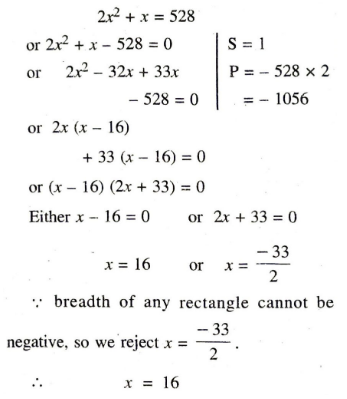
Hence, breadth of rectangular plot = 16 m
Length of rectangular plot = (2 × 16 + 1) m = 33 m
and given problem in the form of Quadratic Equation are
2x² + x – 528 = 0 Ans.
(ii) Let two consecutive positive integers are x and x + 1.
Product of Integers = x (x + 1) = x² + x
According to question,


∵ We are to study about the positive integers, so we reject x = – 18.
∴ x = 17
Hence, two consecutive positive integers are 17, 17 + 1 = 18
and given problem in the form of Quadratic Equation is
x² + x – 306 = 0 Ans.
(iii) Let present age of Rohan = x years
Rohan’s mother’s age = (x + 26) years
After 3 years, Rohan’s age = (x + 3) years
Rohan’s mother’s age = (x + 26 + 3) years
(x + 29) years
∴ Their product = (x + 3) (x + 29)
= x² + 29x + 3x + 87
= x² + 32x + 87
According to question,
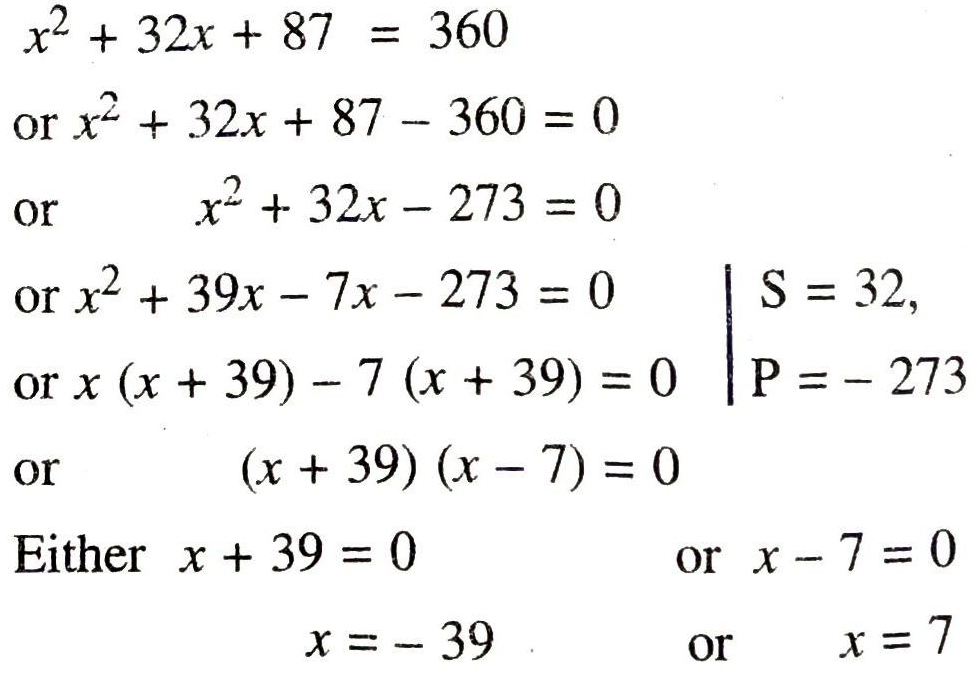
∵ age of any person cannot be negative so, we reject x = – 39
∴ x = 7
Hence, Rohan’s present age = 7 years
and given problem in the form of Quadratic Equation is
x² + 32x – 273 = 0 Ans.
(iv) Let u km/hour be the speed of train.
Distance covered by train = 480 km
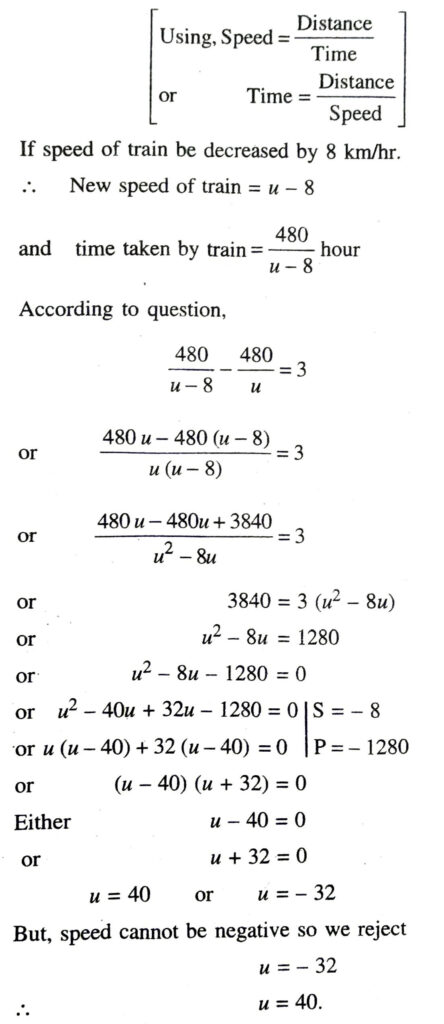
Hence speed of train is 40 km/hr Ans.
TEXT BOOK EXERCISE 4.2
Q. 1. Find the roots of the following quadratic equations by factorisation :
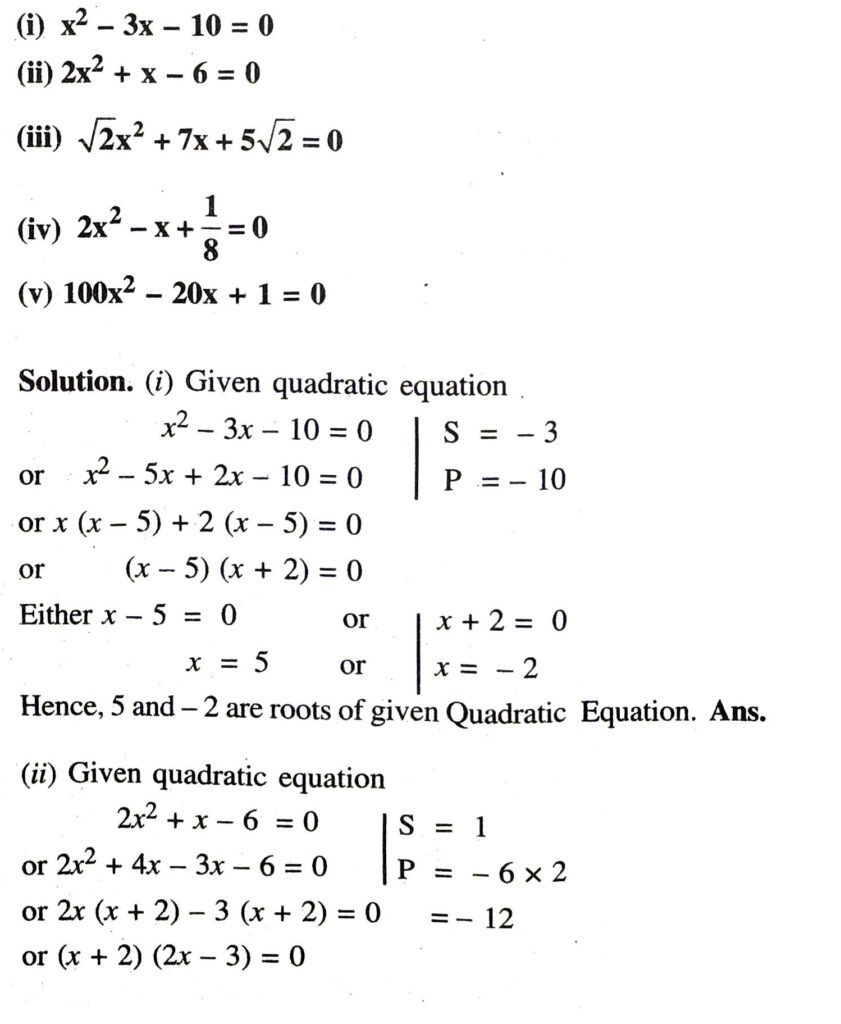
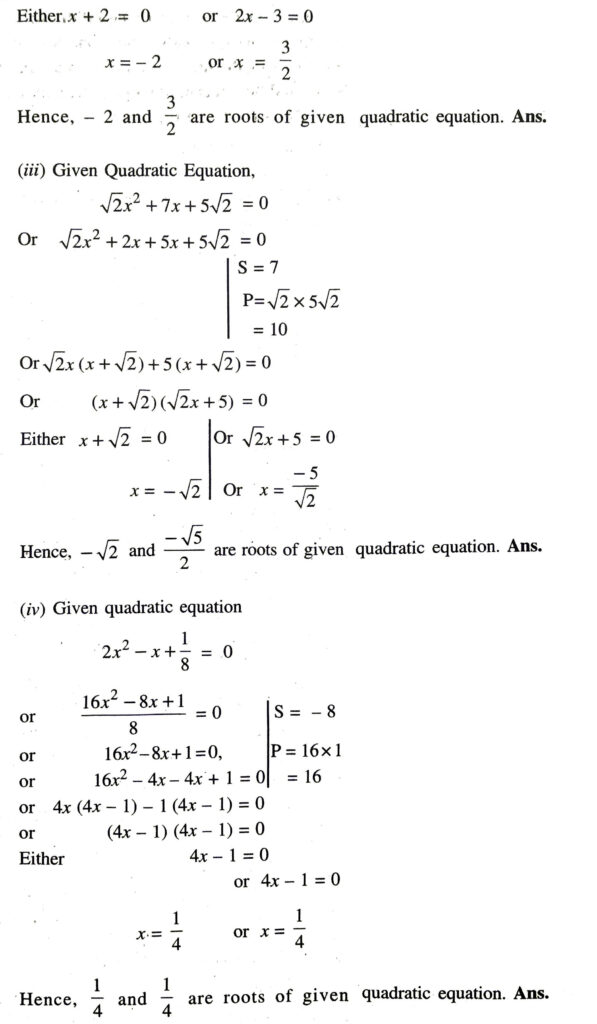
(v) Given quadratic equation

Q. 2. Solve the problems given in Example 1. Statements of these problems are given below:
(i) John and Jivanti together have 45 marbles. Both of them lost 5 marbles each, and the product of the number of marbles they now have is 124. We would like to find out how many marbles they had to start with.
(ii) A cottage industry produces a certain number of toys in a day. The cost of production of each toy (in rupees) was found to be 55 minus the number of toys produced in a day. On a particular day, the total cost of production was ₹ 750. We would like to find out the number of toys produced on that day.
Solution. (i) Let the number of marbles John had be x.
Then the number of marbles Jivanti had = 45 – x
The number of marbles left with John, when he lost 5 marbles =x – 5
The number of marbles left with Jivanti, when she lost 5 marbles
= 45 – x – 5
= 40 – x
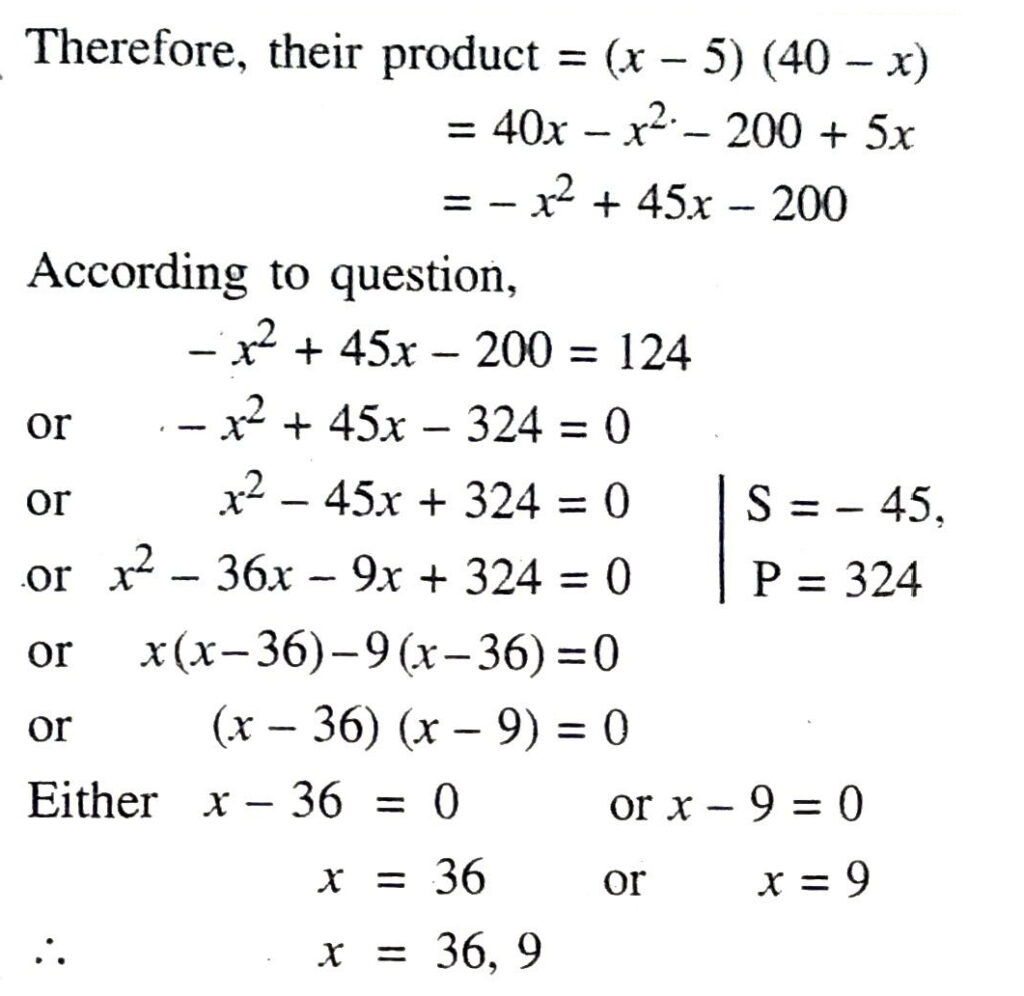
Hence, number of marbles they had to start with were 36 and 9 or 9 and 36 Ans.
(ii) Let the number of toys produced on that day be x.
Therefore, the cost of production (in rupees) of each toy that day
= 55 – x
So, the total cost of production (in rupees) that day = x (55 – x)
According to question,
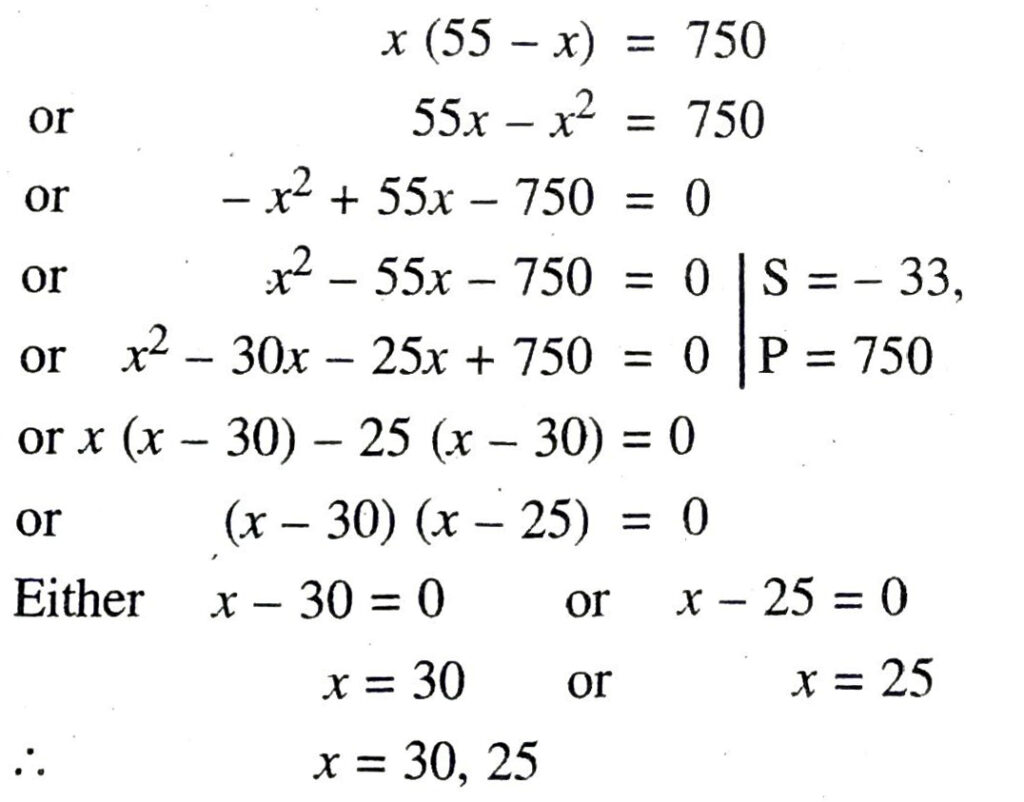
Hence, number of toys produced on that day were 30 and 25 or 25 and 30 Ans.
Q. 3. Find two numbers whose sum is 27 and product is 182.

Hence, two numbers are 13 and 14 or 14 and 13 Ans.
Q. 4. Find two consecutive positive integers, sum of whose squares is 365.
Solution. Let one positive integer = x
2nd positive integer = x + 1
According to question,
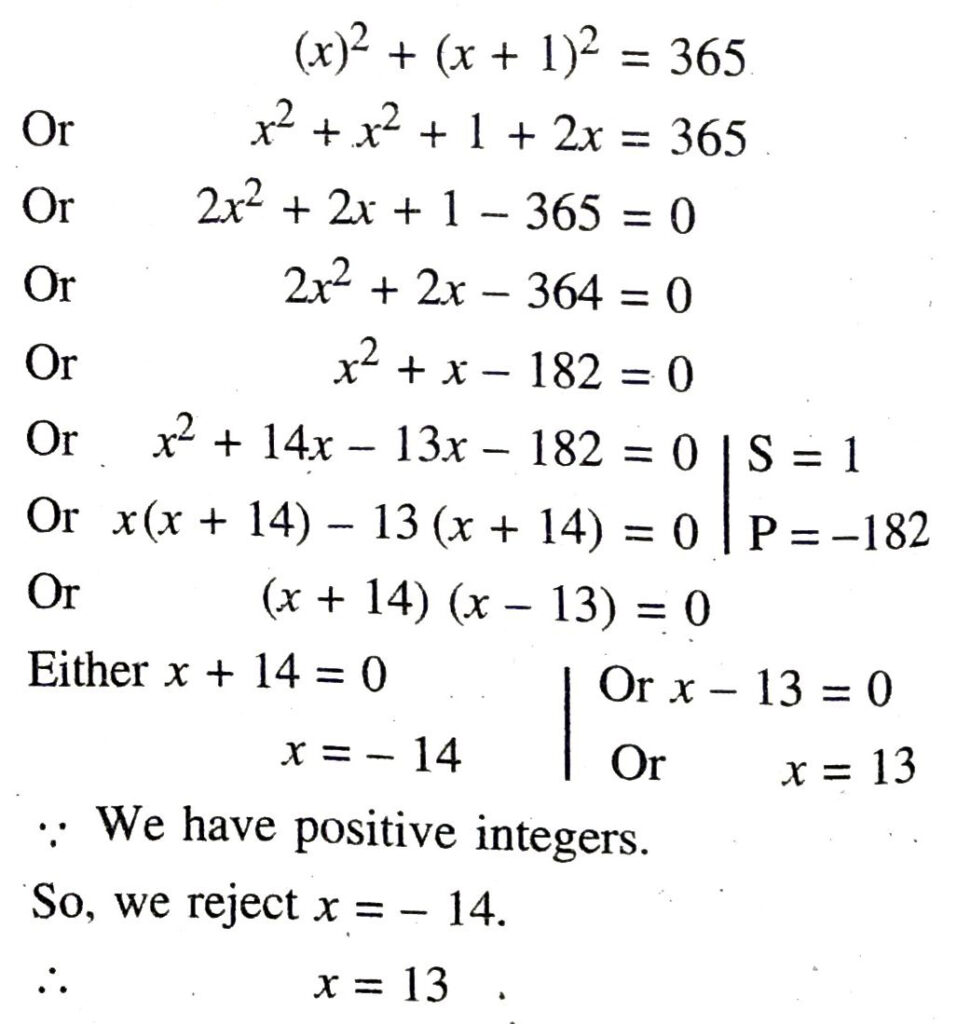
∴ One positive integer = 13
and 2nd positive integer = 13 + 1 = 14
Hence, required consecutive positive integers are 13 and 14 Ans.
Q. 5. The altitude of a right triangle is 7 cm less than its base. If the hypotenuse is 13 cm, find the other two sides.
Solution. Let base of right triangle = x cm
Altitude of right triangle = (x – 7) cm
and hypotenuse of right triangle = 13 cm (Given)
According to Pythagoras Theorem,
(Base)2 + (Altitude)² = (Hypotenuse)²

∵ Length of any triangle cannot be negative. So, we reject x = – 5
∴ x = 12
Hence, base of right triangle = 12 cm
Altitude of right triangle = (12 – 7) cm
= 5 cm Ans.
Q. 6. A cottage industry produces a certain number of pottery articles in a day. It was observed on a particular day that the cost of production of each article (in rupees) was 3 more than twice the number of articles produced on that day. If the total cost of production on that day was 90, find the number of articles produced and the cost of each article.
Solution. Let, number of pottery articles produced by industry in one day = x
Cost of production of each article = ₹ (2x + 3)
∴ Total cost of production in particular day
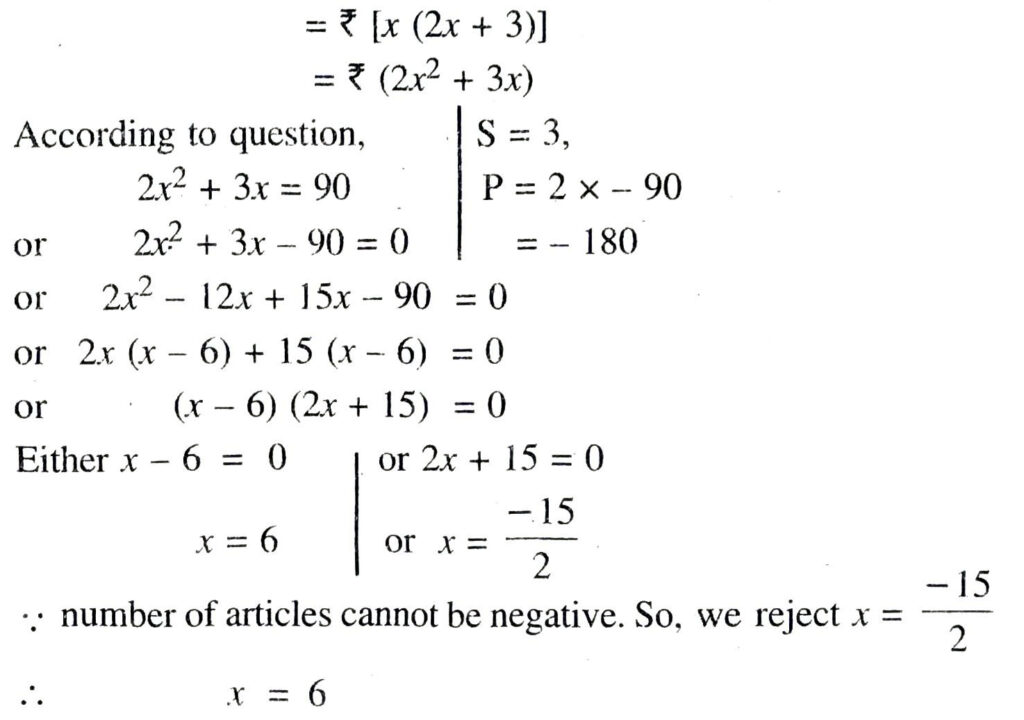
Hence, number of articles produced on certain day = 6
and cost of production of each article
= ₹ [2 x 6 + 3]
= ₹ 15 Ans.
TEXT BOOK EXERCISE 4.3
Q. 1. Find the roots of the following quadratic equations if they exist, by the method of completing the square :
(i) 2x² – 7x + 3 = 0
(ii) 2x² + x – 4 = 0
(iii) 4x² +4√3x +3=0
(iv) 2x² + x + 4 = 0
Solution. (i) Given quadratic equation is

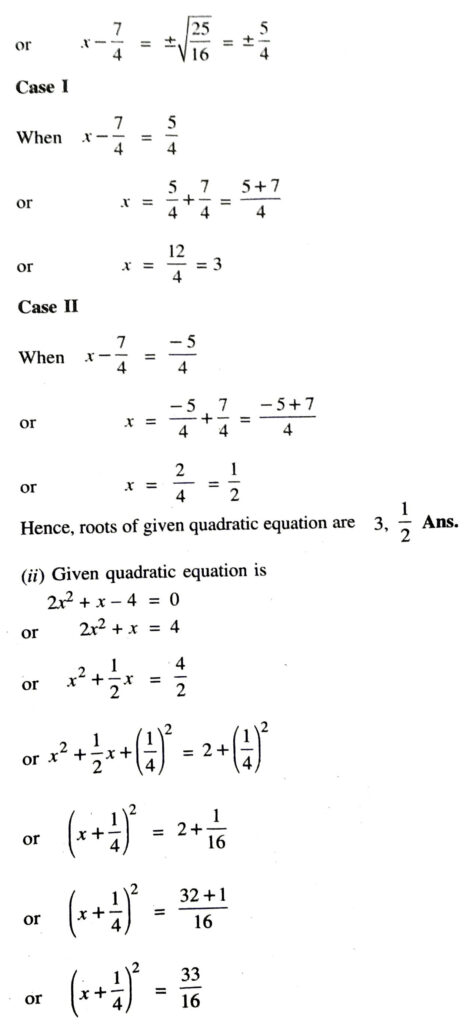
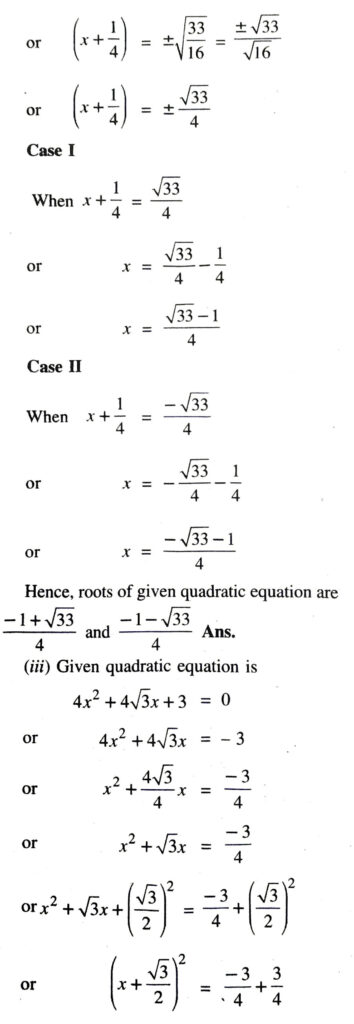

∴ There is no real x which satisfied the given quadratic equation.
Hence, given quadratic equation has no real roots. Ans.
Q. 2. Find the roots of the quadratic equations given in Q. 1 above by applying the quadratic formula. Which of the above two methods do you prefer, and why?
Solution. (i) Given quadratic equation is

(iii) Given quadratic equation is

Since the square of a real number cannot be negative, therefore x will not have any real value.
Hence, there are no real roots for the given quadratic equation. Ans.
From above two questions, we used two methods to find the roots of the quadratic equations. It is very clear from above discussion that quadratic formula method is very convenient as compared to method of completing the square.
Q. 3. Find the roots of the following equations :

(ii) Given equation is

Hence, 2 and 1 are the roots of given quadratic equation. Ans.
Q. 4. The sum of the reciprocals of Rehman’s age (in years) 3 years ago and 5 years from now is 1/3. Find his present age.
Solution. Let Rehman’s present age = x years
3 years ago Rehman’s age = (x – 3) years
5 years from now Rehman’s age (x + 5) years
According to question,

∵ age cannot be negative, so, we reject x = -3
∴ x = 7
Hence, Rehman’s present age = 7 years.
Q. 5. In a class test, the sum of Shefali’s marks in Mathematics and English is 30. Had she got 2 marks more in Mathematics and 3 marks less in English, the product of their marks would have been 210. Find her marks in the two subjects.
Solution. Let Shefali get marks in Mathematics = x
∴ Shefali’s marks in English = 30 – x
According to 1st condition,
Shefali’s marks in Mathematics = x + 2
and Shefali’s marks in English
= 30 – x – 3
= 27 – x
∴ Their product = (x + 2) (27 – x)
= 27x – x² + 54 – 2x
= x² + 25x + 54
According to 2nd condition,
– x² + 25x + 54 = 210
Or – x² + 25x + 54 – 210 = 0
Or – x² + 25x – 156 = 0
Or x² – 25x + 156 = 0
Compare it with ax² + bx + c = 0
∴ a = 1, b = 25, c = 156
Now, b2 – 4ac = (- 25)² – 4 × 1 × 156
= 625 – 624
= 1 > 0

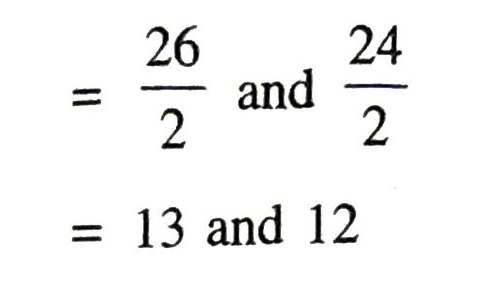
Case I
When x = 13
then Shefali’s marks in Maths = 13
Shefali’s marks in English = 30 – 13 = 17
Case II
When x = 12
then Shefali’s marks in Maths = 12
Shefali’s marks in English = 30 – 12 = 18
Hence, Shefali’s marks in two subjects are 13 and 17 Or 12 and 18 Ans.
Q. 6. The diagonal of a rectangular field is 60 metres more than the shorter side. If the longer side is 30 metres more than the shorter side, find the sides of the field.
Solution. Let shorter side of rectangular field = AD = x m

Longer side of rectangular field = AB = (x + 30) m
and diagonal of rectangular field = DB = (x + 60) m
In rectangle, the angle between the length and breadth is right angle.
∴ ∠DAB = 90°
Now, in right angled triangle DAB, using Pythagoras Theorem,
(DB)² = (AD)² + (AB)²
(x + 60)² = (x)² + (x + 30)²
or x² + 3600 + 120x = x² + x² +900 + 60x
or x² + 3600 + 120x – 2x² – 900 – 60x = 0
or – x² + 60x + 2700 = 0
or x² – 60x – 2700 = 0
Compare it with ax² + bx + c = 0
∴ a = 1, b = – 60, c = – 2700
and b² – 4ac = (- 60)² – 4 . 1 . (- 2700)
= 3600 + 10800
= 14400 > 0

∵ length of any side cannot be negative so, we reject x = − 30
∴ x = 90
Hence, shorter side of rectangular field = 90 m
Longer side of rectangular field = (90 + 30) m = 120 m Ans.
Q. 7. The difference of squares of two numbers is 180. The square of the smaller number is 8 times the larger number. Find the two numbers.
Solution. Let larger number = x
Smaller number = y
According to 1st condition,
x² – y² = 180 ….(1)
According to 2nd condition,
y² = 8x …(2)
From (1) and (2), we get
x² – 8x = 180
or x² – 8x – 180 = 0
Compare it with ax² + bx + c = 0
∴ a = 1, b = – 8, c = – 180
and b² – 4ac = (- 8)² – 4 x 1 x (- 180)
= 64 + 720
= 784 > 0
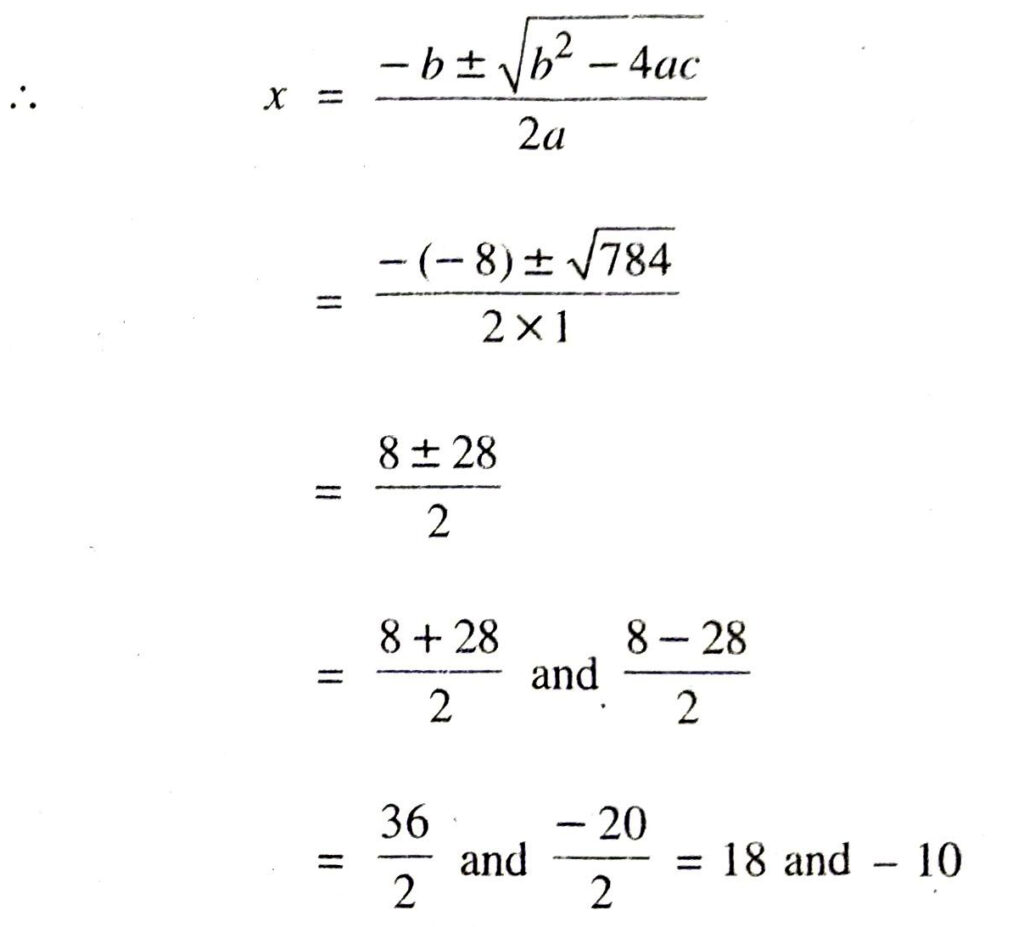
When x = – 10 then from (2),
y² = 8 (- 10) = − 80, which is impossible. So, we reject x = – 10
When x = 18 then from (2),
y² = 8 (18) = 144
or y = ± √144
or y = ± 12
Hence, required numbers are 18 and 12 or 18 and – 12 Ans.
Q. 8. A train travels 360 km at a uniform speed. If the speed had been 5 km/h more, it would have taken 1 hour less for the same journey. Find the speed of the train.
Solution. Let constant speed of the train = x km/hour
Distance covered by the train = 360 km
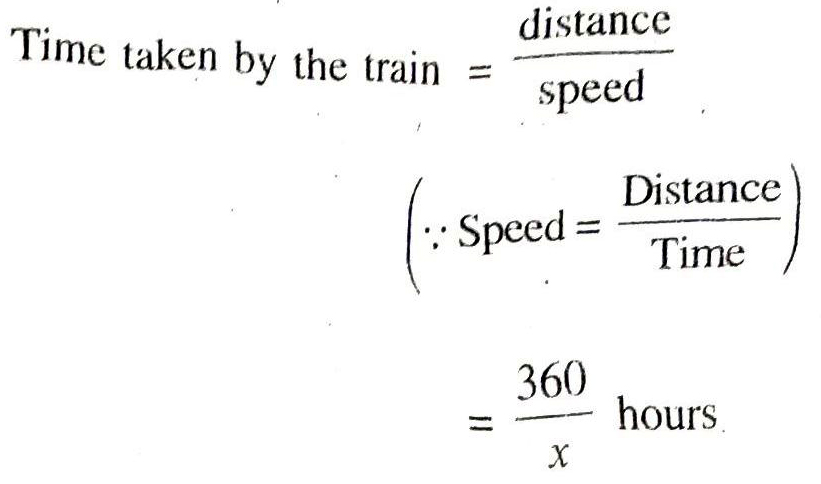
Increased speed of the train = (x + 5) km/hour
∴ Time taken by the train with increased speed = 360/x+5 hour
According to question,
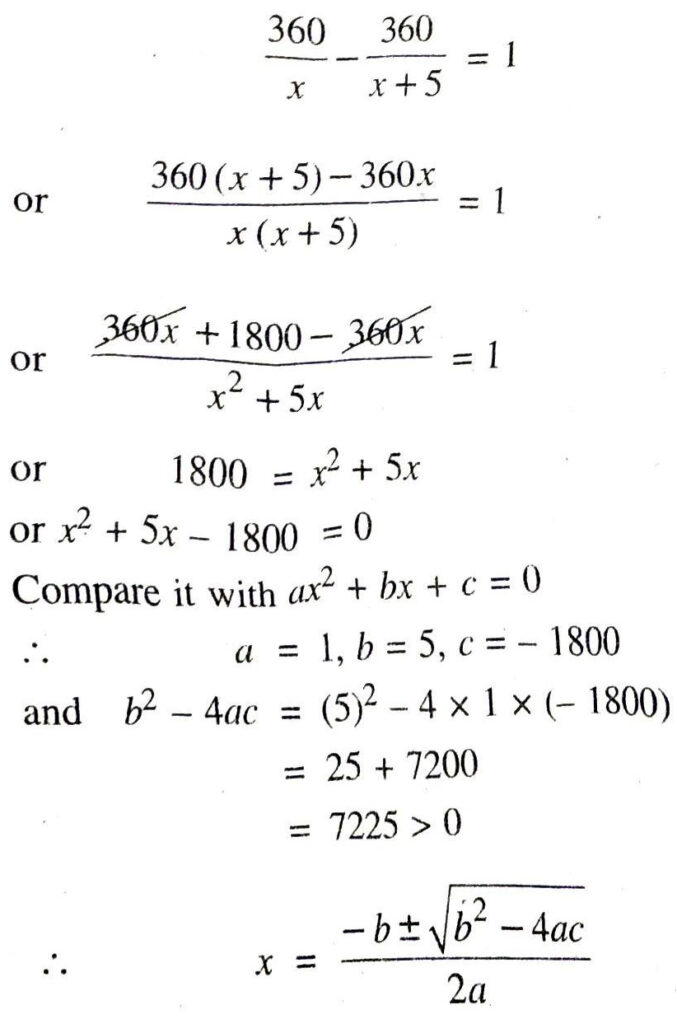
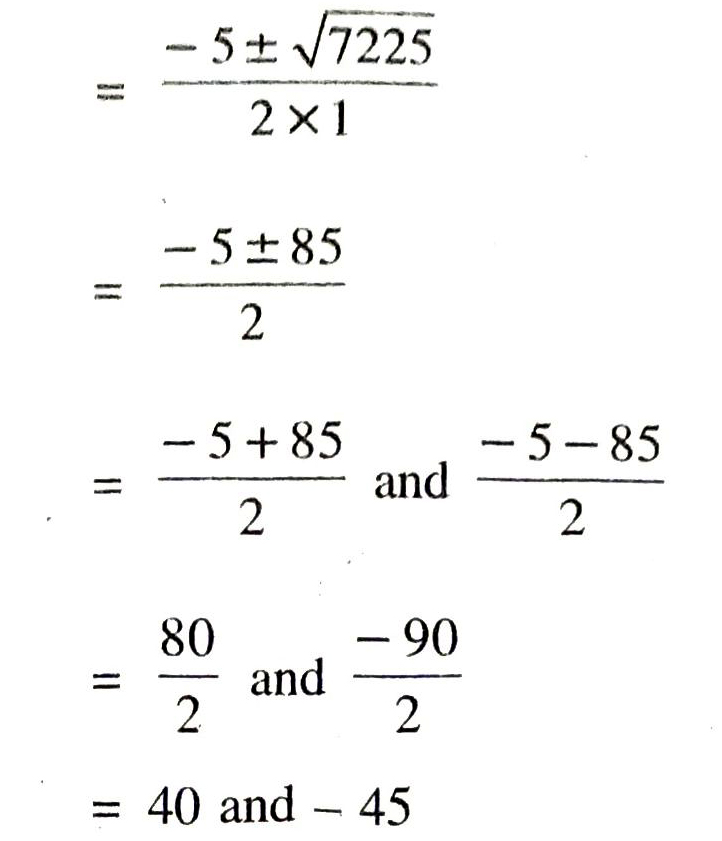
∵ speed of any train cannot be negative. So, we reject x = – 45
∴ x = 40
Hence, speed of train = 40 km/hour Ans.
Q. 9. Two water taps together can fill a tank in  hours. The tap of larger diameter takes 10 hours less than the smaller one to fill the tank separately. Find the time in which each tap can separately fill the tank.
hours. The tap of larger diameter takes 10 hours less than the smaller one to fill the tank separately. Find the time in which each tap can separately fill the tank.
Solution. Let time taken by larger tap to fill the tank = x hours.
Time taken by smaller tap to fill the tank = (x + 10) hours
In case of one hour

From (1) and (2), we get

∵ time cannot be negative. So, we reject x = – 25/4
∴ x = 15
Hence, larger water tap fills the tank = 15 hours and smaller water tap fills the tank
= (15 + 10) hours
= 25 hours Ans.
Q. 10. An express train takes 1 hour less than a passenger train to travel 132 km between Mysore and Bangalore (without taking into consideration the time they stop at intermediate stations). If the average speed of the express train is 11 km/hr more than that of the passenger train, find the average speed of the two trains.
Solution. Let average speed of passenger train = x km/hour
Average speed of express train
= (x + 11) km/hour
Distance between Mysore and Bangalore
= 132 km


∵ speed of any train cannot be negative
∴ x = 33
Hence, speed of passenger train
= 33 km/hour
and speed of express train
= (33 + 11) km/hour
= 44 km/hour Ans.
Q. 11. Sum of the areas of two squares is 468 m². If the difference of their perimeters is 24 m, find the sides of the two squares.
Solution. In case of larger square
Let length of each side of square = x m
Area of square = x² m²
Perimeter of square = 4x m
In case of smaller square
Let length of each side of square = y m
Area of square = y² m²
Perimeter of square = 4y m
According to 1st condition,
x² + y² = 468 ….(1)
According to 2nd condition,
4x – 4y = 24
or 4 (x – y) = 24
or x – y = 6
or x = 6 + y …(2)
From (1) and (2), we get
(6 + y)² + y² = 468
or 36 + y² + 12y + y² = 468
or 2y² +12y + 36 – 468 = 0
or 2y² + 12y – 432 = 0
or y² + 6y – 216 = 0
Compare it with ay² + by + c = 0
∴ a = 1, b = 6, c = – 216
and b² – 4ac = (6)² – 4 × 1 × (- 216)
= 36 + 864
= 900 > 0
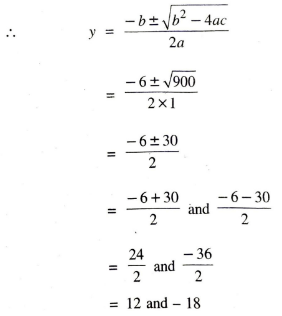
∵ length of square cannot be negative. So, we reject y = – 18
∴ y = 12
From (2), x = 6 + 12 = 18
Hence, sides of two squares are 12 m and 18 m Ans.
TEXT BOOK EXERCISE 4.4
Q. 1. Find the nature of the roots of the following quadratic equations. If the real roots exist, find them :
(i) 2x² – 3x + 5 = 0
(ii) 3x² – 4√3x + 4 = 0
(iii) 2x² – 6x + 3 = 0
Solution. (i) Given quadratic equation is,
2x² 3x + 5 = 0
Compare it with ax² + bx + c = 0
∴ a = 2, b = 3, c = 5
D = b² – 4ac
= (-3)² – 4 x 2 x 5
= 9 – 40
= – 31 < 0
Hence, given quadratic equation has no real roots. Ans.
(ii) Given quadratic equation is,
3x² – 4√3x + 4 = 0
Compare it with ax² + bx + c = 0
∴ a = 3, b = – 4√3, c = 4
D = b² – 4ac
= (-4√3)² – 4 × 3 × 4
= 48 – 48 = 0
∴ given equation has real and equal roots.

Hence, roots of given quadratic equation are  Ans.
Ans.
(iii) Given quadratic equation is :
2x² – 6x + 3 = 0
Compare it with ax² + bx + c = 0
∴ a = 2, b=-6, c = 3
D = b² – 4ac =
= (- 6)² – 4 × 2 × 3
= 36 – 24
= 12 > 0
∴ given equation has real and distinct roots.
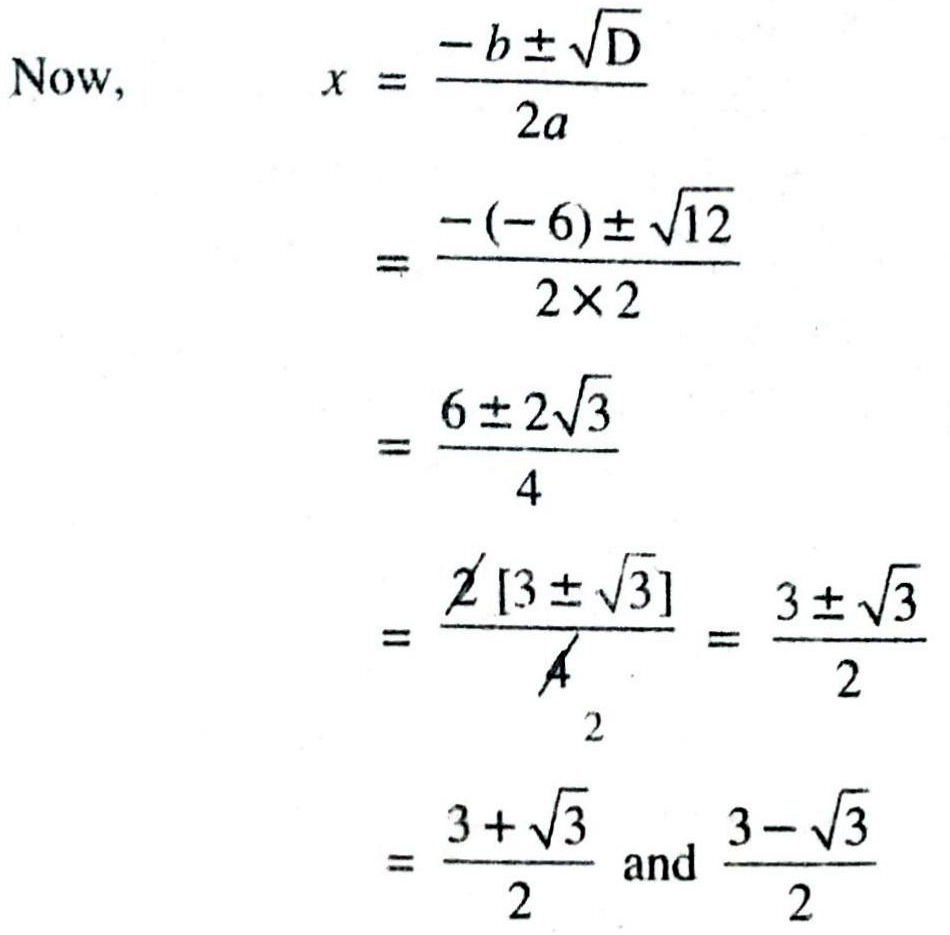
Hence, roots of given quadratic equation are  Ans.
Ans.
Q. 2. Find the values of k for each of the following quadratic equations, so that they have two equal roots.
(i) 2x² + kx + 3 = 0
(ii) kx (x – 2) + 6 = 0
Solution. (1) Given quadratic equation is :
2x² + kx + 3 = 0
Compare it with ax² + bx + c = 0
∴ a = 2, b = k, c = 3
∵ roots of the given quadratic equation are equal.
∴ D = 0
b² – 4ac = 0
or (k)² – 4 × 2 × 3 = 0
or k² – 24 = 0
or k² = 24
or k = ±√24
or k = +±√6 Ans.
(ii) Given quadratic equation is :
kx (x – 2) + 6 = 0
or kx² – 2kx + 6 = 0
Compare it with ax² + bx + c = 0
∴ a = k, b = – 2k, c = 6
∵ roots of the given quadratic equation are equal
∴ D = 0
b² – 4ac = 0
or (- 2k)² – 4 x k x 6 = 0
or 4k² – 24k = 0
or 4k [k – 6] = 0
Either 4k = 0 or k – 6 = 0
k = 0 or k = 6
k = 0, 6 Ans.
Q. 3. Is it possible to design a rectangular mango grove whose length is twice its breadth, and the area is 800 m² ? If so, find its length and breadth.
Solution. Let breadth of rectangular grove = x m
and length of rectangular grove = 2x m
Area of rectangular grove = length x breadth
= [x × 2x] m²
= 2x2 m2
According to question
2x² = 800
x² = 800/2 = 400
x = ± √400
x = ±20
∵ length of rectangle cannot be negative. So, we reject x = – 20
∴ x = 20
∴ breadth of rectangular grove = 20 m
and length of rectangular grove = (2 × 20) m
= 40 m Ans.
Q. 4. Is the following situation possible? If so, determine their present ages.
The sum of the ages of two friends is 20 years. Four years ago, the product of their ages in years was 48.
Solution. Let age of one friend = x years
and age of 2nd friend = (20-x) years
Four years ago,
Age of 1st friend = (x – 4) years
Age of 2nd friend = (20 – x – 4) years
= (16 – x) years
∴ Their product = (x – 4) (16 – x)
= 16x – x² – 64 + 4x
= – x² + 20x – 64
According to Question
– x² + 20x – 64 = 48
Or – x² + 20x – 64 – 48 = 0
Or – x² + 20x – 112 = 0
Or x² – 20x + 112 = 0 …..(1)
Compare it with ax² + bx + c = 0
∴ a = 1, b = – 20, c = 112
D = b² – 4ac
= (- 20)² – 4 × 1 × 112
= 400 – 448
= – 48 < 0
∴ roots are not real
then no real value of x satisfies the quadratic equation (1).
Hence, given situation is not possible. Ans.
Q. 5. Is it possible to design a rectangular park of perimeter 80 m and area 400 m² ? If so, find its length and breadth.
Solution.
Let length of rectangular park = x m
Breadth of rectangular park = y m
∴ Perimeter of rectangular park = 2(x + y) m
and area of rectangular park = xy m²
According to 1st condition
2 (x + y) = 80

When x = 20 then from (1)
y = 40 – 20 = 20
∴ Length and breadth of rectangular park are equal of measure 20 m.
Hence, given rectangular park exist and it is a square. Ans.
Follow on Facebook page – Click Here
Google News join in – Click Here
Read More Asia News – Click Here
Read More Sports News – Click Here
Read More Crypto News – Click Here